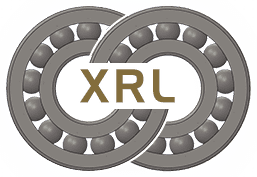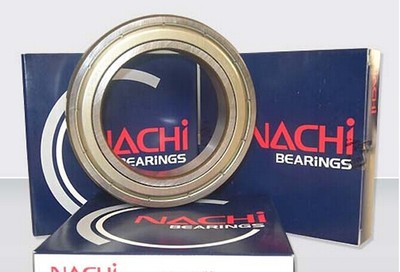NACHI example bearing model: SH6-7208CYDU/GL P4
SH6- : Material symbol Outer ring, inner ring = bearing steel, ball = ceramic (no symbol): outer ring, inner ring, ball = bearing steel
7 : Bearing type code of single row angular contact ball bearing
2 size series code 9: 19 series 0: 10 series 2: 02 series
08 Inner diameter code 00 : Inner diameter size 10 mm 01 : 12mm 02 : 15mm 03 : 17mm 04~ : (inner diameter code)×5mm
Contact angle code C : 15° 7200 AC : 25°
Y cage code Y: polyamide resin cage
DU assembly code U: free assembly (single) DU: free assembly (2 assemblies) DB: back-to-back assembly DF: face-to-face assembly DT: series assembly
/GL Preload class code/GE : Micro preload /GL : Light preload /GM : Medium preload /GH : Heavy preload
P4 precision grade code P5: JIS grade 5 P4: JIS grade 4
Features ● The ball of angular contact ball bearing and the raceway of the inner ring and the outer ring can contact at an angle in the radial direction. When used alone, the axial load is limited to a single direction, and it is suitable for the combined load of axial load and radial load. ● Because this bearing has a contact angle, an axial force component is generated when radial load acts. Therefore, it is generally used in the form of symmetry or pairing on both sides of the shaft. ● There are also types using ceramic balls. Contact angle There are two types of contact angle, 15° and 25°. 15° is used for high-speed applications. 25° is suitable for occasions where axial rigidity is required. The cage is made of polyamide as standard. Please use the polyamide cage below 120°. Dimensional accuracy and rotational accuracy conform to JIS class 5 or 4. Please refer to page 7. Preload ● Set 4 types of standard preload amount. Select the desired preload based on the selection criteria in the table on the right. ● Refer to pages 16 to 18 for the standard preload amount for each series and size.
Assembling For the use of multi-column assembly, please refer to pages 12 to 13. Ceramic ball type In order to reduce the centrifugal force of the ball during high-speed rotation, a ceramic ball with a lower density than bearing steel is used. ● See the table below for various properties of ceramics and bearing steels. ● Add “SH6-” at the beginning of the model number of bearings using ceramic balls. ● The preload and axial rigidity are approximately 1.2 times that of the bearing steel ball type. Preload symbol selection standard E (micro preload) Prevent mechanical vibration and improve accuracy L (light preload) High speed (dmn value of 500,000) still has a certain rigidity M (medium preload) The generation is lighter than the standard speed Rigidity H with higher preload (heavy preload) produces maximum rigidity at low speeds.
Characteristic Unit Ceramic (Si3N4) Bearing Steel (SUJ2) Heat Resistance °C 800 180 Density g/cc 3.2 7.8 Linear Expansion Coefficient 1/°C 3.2×10-6 12.5×10-6 Hardness Hv 1400~1700 700~800 Longitudinal Elasticity coefficient GPa 314 206 Poisson’s ratio − 0.26 0.30 Corrosion resistance − Good and bad magnetic properties − Non-magnetic, strong magnetic conductivity Angular contact ball bearings.
Post time: Jan-27-2022

